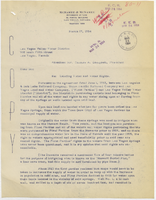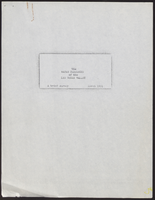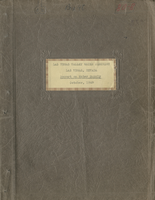Search the Special Collections and Archives Portal
Search Results

Telegram from N. A. Williams (Los Angeles) to Walter R. Bracken (Las Vegas), June 5, 1924
Date
Archival Collection
Description
The water shortage was causing concern for the railroad because low water levels caused the well to spew sand which was very bad for the trains. A new well was needed to increase supply of water.
Text

Letter from Leo A. McNamee (Las Vegas) to Thomas A. Campbell (Las Vegas), March 19, 1954
Date
Archival Collection
Description
Summary of the water rights purchased by the Union Pacific Railroad from Helen Stewart to pass to the Las Vegas Valley Water District.
Text

Postcard of Lorenzi Park, Las Vegas, circa 1930
Date
Archival Collection
Description
The ponds at Lorenzi Park, Las Vegas
Transcribed Notes: Printed on front of postcard: Lorenzi Park at Las Vegas, Nevada; Oakes Photo; Printed on back of postcard: Lorenzi Park at Las Vegas comprises eleven acres of water from artesian wells, furnishing boating, swimming and irrigation.; Also space for one-cent stamp; Printed by Curt Teich & Co., Inc., Chicago, U.S.A.
Image

Aerial photograph of Las Vegas looking south, 1930
Date
Archival Collection
Description
Aerial view of Las Vegas in 1930.
Transcribed Notes: Notes on photo sleeve: 'Shows stockyards and car shops. Creek is overflow from UP artesian well. Site of earliest ranch in area. Creek had mosquito minnows in it - a native species. Only source of water for Las Vegas. Water carried in a 20-24'' wooden pipe.' (James J. Hester, from W.A. Davis, photographer. April 1992)
Image

Letter from General Manager (Las Vegas) to Kelly Ann Le Blanc (New Iberia, Louisiana), November 18, 1952
Date
Archival Collection
Description
Letter written by the General Manager of Las Vegas Land and Water Company to a student in Louisiana who was writing a report on Las Vegas water supply.
Text

Las Vegas water supply in 1936, circa 1937
Date
Archival Collection
Description
Report of the output of the Las Vegas Springs and well, and Las Vegas water consumption for 1936.
Transcribed Notes: handwritten corrections in pencil
Text

The water resources of the Las Vegas Valley: a brief survey, March 27, 1931
Date
Archival Collection
Description
Overview of the water resources in the Las Vegas Valley, includes maps
Text

Las Vegas Valley Water District Report on water supply, October 1949
Date
Archival Collection
Description
Detailed 76 page report with charts, tables and calculations on the water situation in the Las Vegas Valley.
Text

Letter from A. S. Halsted (Los Angeles) to Mr. Knickerbocker, June 11, 1924
Date
Archival Collection
Description
The Las Vegas Land and Water Co. had drilled a new well but they had not filed the paperwork to legally appropriate the water.
Text

Letter from A. S. Halsted (Los Angeles) to Mr. Knickerbocker regarding surface and underground water rights, June 11, 1924
Date
Archival Collection
Description
Halstead believed that if a new well was dug, the railroad and the water company must make sure that all the water from it was appropriated.
Text
